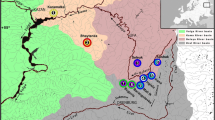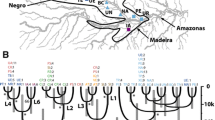Abstract
While currently in a state of recovery in the United Kingdom (UK), the grayling (Thymallus thymallus) remains of conservation interest due to its historical decline, socio-economic value and the potential impact of hatchery-reared stock fish on the genetic structure and diversity of wild populations. However, little is known about the levels and distribution of genetic diversity among UK grayling populations. To this end, 27 UK populations of grayling were genotyped across 10 microsatellite loci and sequenced at the mtDNA D-Loop. All populations clustered into four higher-level groups: Northern England, Southern England, Wales, and group consisting of a mixture of native and introduced populations. Ten populations showed evidence of bottleneck or founder effects, and the effective population size (Ne) was low in all populations. In most cases, historical stocking records agreed with the genetic relationships revealed in the study. A D-Loop haplotype network supported the groupings observed in the nuclear data, while phylogenetic inference places the UK populations amongst Central European samples. The combined datasets demonstrate that many of the UK populations can be treated as separate Management Units and we recommend that to preserve population specific genetic diversity, that stocking should be an intervention of last resort. However, if stocking is deemed essential, brood stock should originate from the river to be stocked.





Similar content being viewed by others
References
Aljanabi SM, Martinez I (1999) Universal and rapid salt-extraction of high quality genomic DNA for PCR-based techniques. Nucleic Acids Res 25:4692–4693
Baker CS, Medrano-Gonzalez L, Calambokidis J, Perry A, Pichler F, Rosenbaum H, Straley JM, Urban-Ramirez J, Yamaguchi M, Von Ziegesar O (1998) Population structure of nuclear and mitochondrial DNA variation among humpback whales in the North Pacific. Mol Ecol 7:695–707
Benjamini Y, Hochberg Y (1995) Controlling the false discovery rate: a practical and powerful approach to multiple testing. J R Stat Soc B 57:289–300
Bergerot B, Lasne E, Vigneron T, Laffaille P (2008) Prioritization of fish assemblages with a view to conservation and restoration on a large scale European basin, the Loire (France). Biodivers Conserv 9:2247–2262
Clement M, Posada D, Crandall KA (2000) TCS: a computer program to estimate gene genealogies. Mol Ecol 9:1657–1659
Cornuet JM, Luikart G (1996) Description and power analysis of two tests for detecting recent population bottlenecks from allele frequency data. Genetics 144:2001–2014
Dawnay N, McEwing R, Thorpe RS, Ogden R (2008) Preliminary data suggests genetic distinctiveness of gyr and saker falcons. Conserv Genet 9:703–707
Di Rienzo A, Peterson AC, Garza JC, Valdes AM, Slatkin M, Freimer NB (1994) Mutational processes of simple-sequence repeat loci in human populations. P Natl Acad Sci-Biol 91:3166–3170
Duchesne P, Turgeon J (2009) FLOCK: a method for quick mapping of admixture without source samples. Mol Ecol Resour 9:1333–1344
Duftner N, Koblmuller S, Weiss S, Medgyesy N, Sturmbauer C (2005) The impact of stocking on the genetic structure of European grayling (Thymallus thymallus, Salmonidae) in two alpine rivers. Hydrobiologia 542:121–1297
Evanno G, Regnaut S, Goudet J (2005) Detecting the number of clusters of individuals using the software STRUCTURE: a simulation study. Mol Ecol 14:2611–2620
Felsenstein J (2004) PHYLIP (phylogeny inference package) version 3.6. Distributed by the author. Department of Genome Sciences, University of Washington, Seattle
Frankham R, Ballou JD, Briscoe DA (2002) Introduction to conservation genetics. Cambridge University Press, Cambridge
Franklin IA (1980) Evolutionary changes in small populations. In: Soule M, Wilcox BA (eds) Conservation biology: an evolutionary and ecological perspective. Sinauer Associates, Sunderland, Massachusett, pp 135–150
Freyhof J, Kottelat M (2008) Thymallus thymallus. In: IUCN 2009. IUCN red list of threatened species, Version 2009.1. www.iucnredlist.org. Accessed 10 Oct 2009
Gardiner (1989) The distribution of grayling. In: Broughton R (ed) Grayling: the fourth game fish. The Crowood Press, Wiltshire
Goudet J (1995) FSTAT (Version 1.2): a computer program to calculate F-statistics. J Hered 86:485–486
Gross R, Kühn R, Baars M, Schröder W, Stein H, Rottmann O (2001) Genetic differentiation of European grayling populations across the Main, Danube and Elbe drainages in Bavaria. J Fish Biol 58:264–280
Gum B, Gross R, Rottmann O, Schröder, Kühn (2003) Microsatellite variation in Bavarian populations of European grayling (Thymallus thymallus): implications for conservation. Conserv Genet 4:659–672
Gum B, Gross R, Kuehn R (2005) Mitochondrial and nuclear DNA phylogeography of European grayling (Thymallus thymallus): evidence for secondary contact zones in central Europe. Mol Ecol 14:1707–1725
Gum B, Gross R, Kuehn R (2006) Discriminating the impact of recent human mediated stock transfer from historical gene flow on genetic structure of European grayling Thymallus thymallus L. J Fish Biol 69(Suppl C):115–135
Gum B, Gross R, Geist J (2009) Conservation genetics and management implications of European grayling, Thymallus thymallus: synthesis of phylogeography and population genetics. Fisheries Manag Ecol 16:37–51
Huelsenbeck JP, Ronquist F (2001) MrBayes: Bayesian inference of phylogenetic trees. Bioinformatics 17:754–755
Ibbotson AT, Cove RJ, Ingraham A, Gallagher M, Hornby DD, Furse M, Williams C (2001) A review of grayling ecology, status and management practice: recommendations for future management in England and Wales. R&D Technical Report W245. Environment Agency and Centre for Ecology and Hydrology
IUCN Red List of Threatened Species (2008) (http://www.iucnredlist.org/). Accessed on 26th Sept 2008
Koskinen MT, Ranta E, Piironen J, Veselov A, Titov S, Haugen TO, Nilsson J, Carlstein M, Primmer CR (2000) Genetic lineages and postglacial colonization of grayling (Thymallus thymallus, Salmonidae) in Europe, as revealed by mitochondrial DNA analyses. Mol Ecol 9:1609–1624
Koskinen MT, Nilsson J, Veselov AJe, Potutkin AG, Ranta E, Primmer CR (2002a) Microsatellite data resolve phylogeographic patterns in European grayling, Thymallus thymallus, Salmonidae. Heredity 88:391–401
Koskinen MT, Knizhin I, Primmer CR, Schlötterer C, Weiss S (2002b) Mitochondrial and nuclear DNA phylogeography of Thymallus spp. (grayling) provides evidence of ice-age mediated environmental perturbations in the world’s oldest body of fresh water, Lake Baikal. Mol Ecol 11:2599–2611
Koyuk A, Bennett A, Tallmon D (2008) ONeSAMP 1.1. http://genomics.jun.alaska.edu/
Lelek A (1984) Threatened fishes of Europe. In: European committee for the conservation of nature and natural resources. Council of Europe. The Freshwater Fishes of Europe 9 AULA-Verlag, Weisbaden
Mayr E (1954) Change of genetic environment and evolution. In: Huxley JS, Hardy AC, Ford EB (eds) Evolution as a process. Allen and Unwin, London
Meldgaard T, Nielsen EE, Loeschcke V (2003) Fragmentation by weirs in a riverine system: a study of genetic variation in time and space among populations of European grayling (Thymallus thymallus) in a Danish river system. Conserv Genet 14:735–747
Moritz C (1994) Defining ‘evolutionary significant units’ for conservation. TREE 9:373–375
Nei M, Maruyama T, Chakraborty R (1975) The bottleneck effect and genetic variability in populations. Evolution 29:1–10
Olsen JB, Bentzen P, Seeb JE (1998) Characterization of seven microsatellite loci derived from pink salmon. Mol Ecol 7:1087–1089
Piry S, Luikart G, Cornuet JM (1999) BOTTLENECK: a computer program for detecting recent reductions in the effective population size using allele frequency data. J Hered 90:502–503
Piry S, Alapetite A, Cornuet JM, Paetkau D, Baudoin L, Estoup A (2004) GeneClass2: a software for the genetic assignment and first generation migrant detection. J Hered 95:536–539
Pritchard JK, Stephens M, Donnelly P (2000) Inference of population structure from multilocus genotype data. Genetics 155:945–959
Raymond M, Rousset F (1995) GENEPOP (version 1.2): population genetics software for exact tests and ecumenicism. J Hered 86:248–249
Regan CT (1911) The freshwater fishes of the British Isles. Methuen, London
Reiman BE, Allendorf FW (2001) Effective population size and genetic conservation criteria for bull trout. North Am J Fish Manag 21:756–764
Rosenburg NA (2004) Distruct: a program for the graphical display of population structure. Centre of Computational Medicine and Biology, Department of Human Genetics, University of Michigan, MI, USA
Saiki RK, Scharf S, Faloona F, Mullis KB, Horn GT, Erlich HA, Arnheim N (1985) Enzymatic amplification of beta-globin genomic sequences and restriction site analyses for diagnosis of sickle-cell anemia. Science 230:1350–1354
Schuelke M (2000) An economic method for the fluorescent labelling of PCR fragments. Nat Biotechnol 18:233–234
Scribner KT, Gust JR, Fields RL (1996) Isolation and characterization of novel microsatellite loci: cross-species amplification and population genetic applications. Can J Fish Aquat Sci 53:833–841
Sušnik S, Snoj A, Dovc P (1999a) Microsatellites in grayling (Thymallus thymallus): comparison of two geographically remote populations from the Danubian and Adriatic river basin in Slovenia. Mol Ecol 8:1756–1758
Sušnik S, Snoj A, Dovc P (1999b) A new set of microsatellite markers for grayling: BFRO014, BFRO015, BFRO016, BFRO017 and BFRO018. Anim Genet 30:478
Sušnik S, Berrebi P, Dovc P, Hansen MM, Snoj A (2004) Genetic introgression between wild, stocked salmonids, the prospects for using molecular markers in population rehabilitation: the case of the Adriatic grayling (Thymallus thymallus L. 1785). Heredity 93:273–282
Swatdipong A, Primmer CR, Vasemag A (2010) Historical and recent genetic bottlenecks in European grayling, Thymallus thymallus. Conserv Genet 11:279–292. doi:10.1007/s10592-009-0031-x
Taberlet P, Bouvet J (1994) Mitochondrial DNA polymorphism, phylogeography, and conservation genetics of the brown bear Ursus arctos in Europe. Proc R Soc Lond B 255:195–200
Tallmon DA, Koyuk A, Luikart G, Beaumont MA (2008) ONeSAMP: a program to estimate effective population size using approximate Bayesian computation. Mol Ecol Resour 8:299–301
Templeton AR, Crandall KA, Sing CF (1992) A cladistic analysis of phenotypic associations with haplotypes inferred from restriction endonuclease mapping and DNA sequence data. 111. Cladogram estimation. Genetics 132:619–633
Uiblein F, Jagsch A, Honsig-Erlenburg W, Weiss S (2001) Status, habitat use, and vulnerability of the European grayling in Austrian waters. J Fish Biol 59(supp A):223–247
Weir BS, Cockerham CC (1984) Estimating F-Statistics for the analysis of population structure. Evolution 38:1358–1370
Weiss S, Persat H, Eppe R, Schlötterer C, Uiblein F (2002) Complex patterns of colonization and refugia revealed for European Grayling Thymallus thymallus, based on complete sequencing of the mitochondrial DNA control region. Mol Ecol 11:1393–1407
Werle E, Schneider CS, Renner M, Volker M, Fiehn W (1994) Convenient single-step, one tube purification of PCR product for direct sequencing. Nucleic Acids Res 22:4354–4355
Wheeler A (1977) The origin and distribution of the freshwater fishes of the British Isles. J Biogeogr 4:1–24
Wilson TK (1963) How our rivers got their grayling. Fishing, June, 9–10
Wilson TK (1966) Trout by all means. Angling Times, Peterborough
Youngson AF, Jordan WC, Verspoor E, McGinnity P, Cross T, Ferguson A (2003) Management of salmonid fisheries in the British Isles: towards a practical approach based on population genetics. Fish Res 62:193–209
Acknowledgements
The authors would wish to thank The Grayling Society and the Environment Agency for funding MIT and ND, and coordinating sample collection. We would also like to thank the anglers who caught samples for the project.
Author information
Authors and Affiliations
Corresponding author
Rights and permissions
About this article
Cite this article
Dawnay, N., Dawnay, L., Hughes, R.N. et al. Substantial genetic structure among stocked and native populations of the European grayling (Thymallus thymallus, Salmonidae) in the United Kingdom. Conserv Genet 12, 731–744 (2011). https://doi.org/10.1007/s10592-010-0179-4
Received:
Accepted:
Published:
Issue Date:
DOI: https://doi.org/10.1007/s10592-010-0179-4




